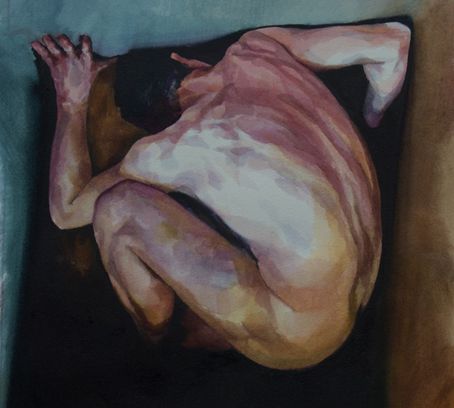KEEPING AFLOAT is an exchange between Studio75 and La Clinica Mundana Valencia, Spain. Studio 75 hosted the first part, a show of Valencian artists. The show was put together by curators Black Duck, (who is well know for curating international shows and festivals of video art and artist’s moving image) and Red Nomade. The result was show which was an interesting and diverse “snapshot” of current art practice in Spain today.
Talking to the artists, it’s clear that the current economic crisis in Spain is of real concern and is affecting their lives. It’s not just about losing funding; about losing studios, flats, jobs. What was heartening, however, was their determination to refocus, and keep doing art, even redoubling the energy given to art.
Paula Bonet is a young artist who’s currently practicing a version of street art that is simple but works very well for the public eye. Large scale versions of her black and white hand drawn self portraits are glued onto the wall – in the gallery or the street or in the case of Studio 75, both. She then colours them by hand, giving them vibrancy and expression. When she was installing at Studio 75 the local school was just getting out, and gaggles of little schoolgirls soon gathered, exclaiming over the work. The freshness of this “female” approach to street art resonated strongly with the young girls, as well as providing a strong point of interest on the Studio 75 walls. Bonet is also working with combining drawing and photography; simple tools and methods harnessed to a creative and fresh approach.
Daniel Granero, 35, brought a collection of small paintings and handmade artist books to London. These provided hours of fascinated perusal, as each work is so finely detailed and resonant in both subject and technique that the visitors could not leave them alone. The artist works through his influences which range from the prehistoric cave paintings of the local region, to the Spanish greats from Velasquez to Miro, in works which show a deep appreciation for the history (and prehistory) of Spanish art and what it meant, and still means, to be a painter in Spain, examining this legacy. It may be hard for Anglo-American artists to appreciate, since painting has not been a major art form until arguably the 19th century (some would argue not until the 20th). But for Spanish (as well as Italian and French) painters, the weight of history is something that cannot be avoided. (Picasso knew this well, as his many interpretations of Velasquez and other painters attest.) Granero’s own approach is very much rooted in a deep appreciation for the geology and landscape of his region of Spain: his skilful colour palette is drawn directly from the earth, sea and sky of the region. Part of his practice is a kind of landart: he makes objects from ordinary materials, paints them, then leaves them in the landscape to transform and be transformed by it. This process is not so much about “making art” as about exploring the relationship between art and nature, and it finds its way back into the paintings.
Black Duck and Red Nomade put together a show that crosses artistic disciplines, and is brought together by all the work’s concern with the exploration of “lines, colours and shapes”, in different ways. The show counterpointed the “handmade” works of Bonet, Granero and drawings by sculptor Claudia Martinez with digital art by Ima Pico and Cristina Ghetti. Pico photographs street signs and graffiti then reconfigures them into posters and vinyl stickers that disassociate the texts from their original meaning. Ghetti’s hypnotic work is in the Op Art tradition and she uses both digital and painting (acrylic on canvas) as well as digital animation.
As a “pop up” show of works that could be fitted into a suitcase, it gave a tiny glimpse of these artists’ practice, but it certainly showed that Valencia is alive and well as a cultural hub.
Keeping Afloat was chosen by the curators to assert that artists are survivors – and that the health of artistic vision and practice has little to do with wealth of nations.





